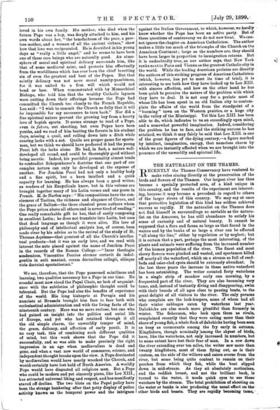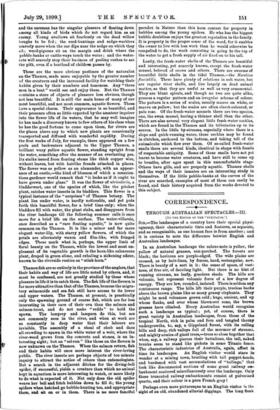THE NATURALIST ON THE THAMES.
RECENTLY the Thames Conservancy have ventured to make rules aiming directly at the preservation of the birds and flowers of the Thames. Our largest river has thus become a specially protected area, of a kind unique in this country, and the results of the experiment are interest- ing, because it may become a precedent in regard to others of the larger rivers of this country. We may say at once that protective legislation of this kind has seldom achieved success so rapidly. If the naturalist on the Thames does not find himself in surroundings so enviable as the natura- list on the Amazons, he has still abundance to satisfy his sense of curiosity and of natural beauty. It cannot be supposed that a flora and fauna so large as that found in the waters and by the banks of so large a river can be affected "all along the line," either by regulation or by neglect; but it is certain that a part, perhaps the most interesting, of the plants and animals were suffering from the increased number of the human population of the river. The finest and most showy flowers were plucked and wasted, and sportsmen killed off nearly all the waterfowl, which on a stream so full of reed- beds and osier-clad eyots should be extremely abundant. In the last three years the increase in these native waterfowl has been astonishing. The writer counted forty waterhens in a single strip of meadow early one morning, by a frequented part of the river. They are also becoming very tame, and, instead of instantly diving and disappearing, swim with their broods of all ages close to passing boats, to the great delight of all visitors to the river. The only persons who complain are the lock-keepers, some of whom had all their winter cabbages eaten by waterhens last year. Dabchicks are also much more plentiful than formerly in winter. The fishermen, who look upon them as rivals, complained recently that they were eating more than their share of young fish, a whole flock of dabchicks having been seen as busy as cormorants among the fry early in autumn. Kingfishers, though nominally ;among the shyest of birds, have, like the waterhens, not only increased in numbers, but to some extent have lost their fear of man. In a row down the river extending over ten miles, the writer saw more than twenty kingfishers, most of them flying out, as is their custom, on the side of the willows and osiers averse from the river, but some being quite content to remain on their perches from which they fish, while the boat slipped down in mid-stream. As they sit absolutely motionless, and the reddish breast, and not the brilliant back, is turned to the water, it needs quick eyes to see these watchers by the stream. The total prohibition of shooting on the water or banks is also producing the usual effect on the other birds and beasts. They are rapidly becoming tame,
and the oarsman has the singular pleasure of floating down among all kinds of birds which do not regard him as an enemy. Young swallows sit fearlessly on the dead willow boughs to be fed ; the reed-buntings and sedge-warblers scarcely move when the oar dips near the sedge on which they sit ; wood-pigeons sit on the margin and drink where the pebble-banks or cattle-ways touch the water ; and the water- rats will scarcely stop their business of peeling rushes to eat the pith, even if a boatload of children passes by.
These are the more obvious pastimes of the naturalist on the Thames, made more enjoyable by the greater number of the creatures and the increased facility for watching their habits given by their numbers and tameness. Any "three men in a boat " would see and enjoy them. But the Thames contains a store of objects of pleasure less obvious, though not less beautiful. It is still the main home of many of our most beautiful, and not most common, aquatic flowers. These Lave a special charm. Their appearance is so beautiful, and their presence often so little expected by the amateur inquirer into the flower life of its waters, that he may well imagine he has made a discovery known to few others of his class when he has the good fortune to come upon them, for rivers are the places above any to which new plants are occasionally transported and diffused with wonderful rapidity. Daring the first weeks of July, for example, there appeared on a few pools and backwaters adjacent to the Upper Thames, a brilliant waxy yellow aquatic flower, standing upright from the water, something after the manner of an everlasting pea. Its stalks issued from floating stems like thick copper wire, without leaves, but with hairlike fronds attached in places. The flower was as yellow as an alamander, with an appear- ance of an exotic,—the kind of blossom of which a conscien- tious gardener would remark that " it looks as if it ought to have grown under glass." It was the flower of utricularia, bladderwort, one of the species of which, like the pitcher plant, catches water insects in its bladders. This flower is a typical instance of the " surprises " of Thames botany. The plant lies under water, is hardly noticeable, and yet puts forth this beautiful flower, for a brief time only; when the bladders fill with water, the plant sinks, and disappears from the river landscape till the following summer calls it once more for a brief life on the surface. The water-villarsia, once described as a "rare floating aquatic," is now quite common on the Thames. It is like a minor and far more elegant water-lily, with starry yellow flowers, of which the petals are alternately waxen and film-like, with fringed edges. These mark what is, perhaps, the upper limit of floral beauty on the Thames, while the lowest and most un- pleasant of its vegetable growth is the horn-like calcareous plant, draped in green slime, and exhaling a sickening odour, known to the riverside rustics as "stink-horn."
Thames fish are so entirely in the province of the anglers, that their habits and way of life are little noted by others, and, it must be confessed, are not greatly studied by those whose pleasure in life it is to catch them. The fish life of the Severn is far more attractive than that of the Thames, because the migra- tory salmonoids and sea fish still have access to its lower and upper waters. The Thames, at present, is practically only the spawning ground of coarse fish, which are far less interesting in their care of their ova than the salmon and salmon-trout, and do not make " redds" to hold the spawn. The lamprey and lampern do this, but are not commonly seen in the river, and when at work are so constantly in deep water that their labours are invisible. The assembly of a shoal of chub and dace all crowding to spawn in the white water of a weir, where the river-weed grows from the concrete and stones, is an in- teresting eight ; but an " eel-ran" like those on the Severn is now unknown on the Thames. When the salmon return, fish and their habits will once more interest the river-loving public. The river insects are perhaps objects of too minute inquiry to attract the notice of others than entomologists. But a search in the adjacent ditches for the diving-bell spider, if successful, yields a creature than which no animal kept in aquarium is more interesting to watch, or more likely to do what is expected of it. Not only does the old spider weave her bell and fetch bubbles down to fill it; the young spiders when hatched go bubble-hunting too, and appropriate them, and sit on or in them. There is no more fanciful paradox in Nature than this keen contest for property in bubbles among the young spiders. He who has the biggest bubble doubtless enjoys the greatest reputation in the family. It is property in the proper sense of the word, for it enables the owner to live with less work than he would otherwise be compelled to do, the work consisting in going to the top of the water to get a fresh supply of air fixed on to his tall.
Lastly, the fresh-water shells of the Thames are beautiful and interesting, yet scarcely known, except the fresh-water mussel, beloved of crows and others. There are swarms of beautiful little shells in the tidal Thames,—the Neretina flur;atills. These have plenty of relations in salt water, but are regular river shells, and live largely on dead animal matter, so that they are useful as well as very ornamental. They are blunt spirals, and though no two are quite alike, possess a regular pattern and an irregular scheme of colour. The pattern is a series of scales, usually mauve on white, or mauve on yellow; but the scales are often claret-coloured, or pale rose. Of the fresh-water mussels there are two species, one, the swan mussel, having a thinner shell than the other. There are also several very elegant little fresh-water cockles, which are found in the Thames and its tributaries up to its source. In the little by-streams, especially where there is a slope and quick-running water, these cockles may be found in clutches, anchored to the bottom, and taking toll of the animalcule: which flow over them. Of so-called fresh-water snails there are several kinds, identical in shape with fossils of respectable antiquity. Some of these snails have not yet learnt to become water creatures, and have still to come up to breathe, after ages spent in this uncomfortable stage. Others have gills, and are properly aquatic. Thames shells and the ways of their inmates are an interesting study in themselves. If the little pebble-banks at the curves of the river are searched, examples of most of them can easily be found, and their history acquired from the works devoted to this subject.



































 Previous page
Previous page